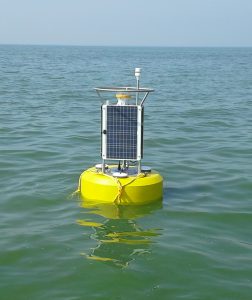Synthesis and Review of Great Lakes Observing Requirements
Dates: August 31-September 2, 2016
Leads: Tom Johengen, University of Michigan-CILER; Steve Ruberg, NOAA GLERL; Kelli Page, GLOS; Michael Twiss, Clarkson University
GLERL Research Program: Observing Systems and Advanced Technology
Summit Summary
Goals: Observing systems around the Great Lakes provide real-time physical, chemical, and biological data that are used to predict weather, ice-cover, water levels, harmful algal blooms (HABs), and many other variables that are used by researchers, businesses, and the public to make decisions. These observing systems range from in-lake instrumentation mounted on buoys, to remote sensing technologies that use satellite, airborne, and ship-based sensors. Keeping observing systems up-to-date with the latest technology, and making sure they give stakeholders the information they need in real-time, is a continual challenge.
Summit participants focused on examining Great Lakes Observation requirements and identify critical gaps in assets, technologies, infrastructure, data products, or data dissemination.
Topical Sessions: Discussion was organized into three topical sessions. Each topical session began with a summary of a previous User Needs Assessments synthesized by the Great Lakes Observing System (GLOS), after which the following questions were addressed:
• What Observing system technologies and systems are we currently using?
• What would an idealized observing system look like to support research and management?
• What is feasible now, what is feasible in the 3-5 year horizon
The discussion was intended to identify gaps and future prioritization of new sensors, observing systems, regional infrastructure/capacity, and data management/product output.
Session A. Resilient Coastal Communities and Economies
• Safe efficient commercial transportation
• Safe recreational boating
• Impacts of hazards and climate change (e.g., Lake level, meteo-tsunami, rip-currents)
• Improved coastal water quality that supports human health and coastal ecosystem services
• Improved coastal planning and management
Session B. Healthy Ecosystems
• Improved understanding of ecosystems to inform resource management decisions (Adaptive Management)
• Healthy habitat (habitat mapping, endangered species)
• Mitigating Invasive species (impacts of invasives, early detection)
• Sustainable fisheries and resilient food webs
Session C. Climate Adaptation and Mitigation
• Improved scientific understanding of the changing climate system and its impacts (thermodynamics, ice cover, meteorology, lake levels, rainfall-loading)
• Mitigation and adaptation efforts supported by sustained, reliable, and timely climate services
